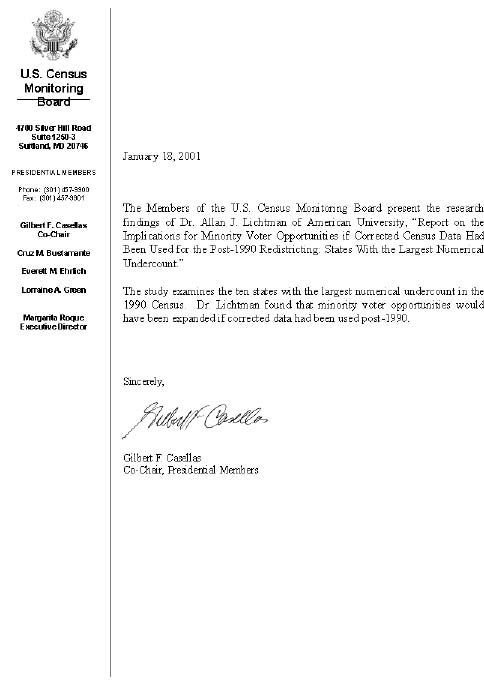|
| Presidential
Members Report: Implications for Minority Voters in 2001 January, 2001 |
|
Report On the Implications for Minority Voter Opportunities if Corrected Census
Data Had Been Used For The Post-1990 Redistricting: States With The Largest
Numerical Undercount
Prepared
For
U.S.
Census Monitoring Board
By
Allan
J. Lichtman, Chair
Department
of History
American
University
Washington,
DC 20016
January
2001
Objectives
of the Study
This
report considers whether the use of corrected census data in the post-1990
redistricting, as opposed to the uncorrected data actually used for that redistricting
cycle, would have had the potential to expand the opportunities for minority
voters to participate fully in the political process and elect candidates
of their choice.1 Corrected data refers to population counts corrected
through scientific sampling for the undercounting of population groups. The
Census Bureau released such corrected data, partitioned to the block level,
after states completed the post-1990 redistricting process. This analysis
examines ten states with the largest numerical difference between uncorrected
and corrected population, according to census reports.2 This difference
is termed the net undercount. Henceforth, the general term undercount will
refer to the net undercount. The ten states and their undercounts for the
total population and whites and minorities are listed in Table 1 below. Table
2 reports differences in the white and minority composition of the total uncorrected
population and of the undercount.

Presidential
Members
4700
Silver Hill Road
Suite 1250 _ 3
Suitland, MD 20746
(301) 457-9900
www.cmbp.gov
email: comment@cmbp.census.gov
|
|
|





